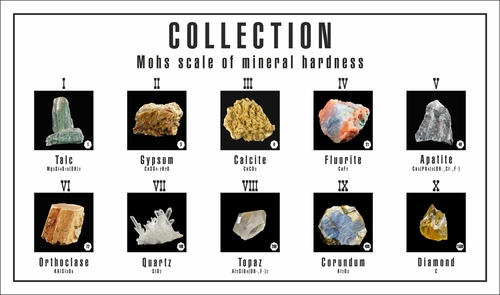When it comes to jewellery, we often marvel at the sparkle of gemstones, the luster of pearls, and the brilliance of precious metals. However, beyond their aesthetic allure lies a fundamental aspect that significantly influences their durability and longevity: hardness. Enter the Mohs scale—a simple yet indispensable tool in the world of jewelry that helps us understand and appreciate the hardness of gemstones and minerals.
What is the Mohs Scale?
Named after Friedrich Mohs, a German mineralogist who devised it in 1812, the Mohs scale stands as one of the most widely used systems for measuring the hardness of minerals. Mohs recognized the need for a practical method to differentiate between various minerals based on their hardness, and thus, he introduced this ingenious scale.
The essence of the Mohs scale lies in its simplicity and effectiveness. Rather than relying on complex scientific instruments, the Mohs scale employs a straightforward comparative method. It evaluates the ability of one mineral to scratch another, thereby establishing a relative hardness scale from 1 to 10.
At its core, the Mohs scale ranks minerals based on their resistance to being scratched by other substances. A mineral with a higher Mohs hardness value can scratch a mineral with a lower value, while it cannot be scratched by a mineral with a lower value. This principle allows for a quick and practical assessment of mineral hardness, making it invaluable not only to mineralogists but also to jewelers, geologists, and enthusiasts alike.
The scale begins with talc, assigned a value of 1, which represents the softest mineral. As the scale progresses, each subsequent mineral has the ability to scratch those preceding it. For instance, gypsum, ranked at 2 on the Mohs scale, can be scratched by talc but can scratch calcite, which ranks higher at 3. This hierarchical arrangement continues until it reaches diamond, the hardest naturally occurring substance known to man, which sits at the top with a perfect score of 10.

In the context of jewellery, the Mohs scale provides invaluable insights into the durability and suitability of gemstones for different types of jewellery. By understanding the hardness of gemstones relative to one another, jewellers and consumers can make informed decisions when selecting and caring for their prized pieces. Whether it’s choosing a diamond for an engagement ring or selecting pearls for a necklace, the Mohs scale serves as a guiding light, ensuring that jewelry remains not only beautiful but also resilient against the tests of time and wear.
Importance in Jewellery
1. Durability:
In the realm of jewellery, durability is paramount. Gemstones subjected to everyday wear, such as rings and bracelets, are prone to abrasion and scratches. Understanding the hardness of gemstones helps jewelers and consumers alike select stones that can withstand daily use without losing their luster or becoming damaged.
2. Protection against Wear:
Gemstones with higher Mohs hardness ratings are less likely to get scratched or abraded. For instance, diamonds, which top the Mohs scale at 10, are exceptionally hard and can withstand scratching from most other materials, making them ideal for everyday jewelry that experiences significant wear.
3. Care and Maintenance:
Knowing the Mohs hardness of gemstones guides us in their care and maintenance. Softer gemstones, such as pearls and opals, require gentler handling and storage to prevent scratches and surface damage. Additionally, when cleaning jewelry, understanding the Mohs scale helps avoid using abrasive cleaners or methods that could harm delicate stones.
4. Design Considerations:
Jewellery designers often take Mohs hardness into account when creating pieces. Pairing gemstones with similar hardness levels minimizes the risk of one stone scratching another. Alternatively, contrasting hardness levels can be intentionally utilised for aesthetic effects, but with careful consideration of the durability implications.
5. Identifying Gemstones:
The Mohs scale can also aid in identifying gemstones. By performing a simple scratch test using common materials with known hardness levels, such as fingernails (2.5) or a steel knife (5.5), one can determine the approximate hardness of a gemstone and narrow down its identity.
Practical Applications
Gemstone Selection: When purchasing jewelry, consider the hardness of the gemstones in relation to how and where you plan to wear them.
Jewellery Maintenance: Follow appropriate care guidelines based on the hardness of your gemstones to preserve their beauty and longevity.
Custom Designs: Work with jewellers who understand the Mohs scale to create bespoke pieces that balance aesthetics with durability.
Education: Equip yourself with knowledge about the Mohs scale to make informed decisions when buying, wearing, and caring for jewellery.
In conclusion, while the Mohs scale may seem like a simple concept, its significance in the world of jewelry cannot be overstated. By understanding the hardness of gemstones and minerals, we can make informed choices that enhance the beauty and longevity of our cherished jewellery pieces, ensuring they sparkle for generations to come.
